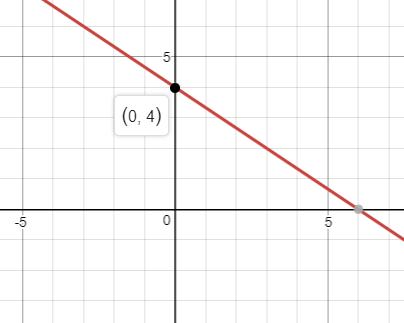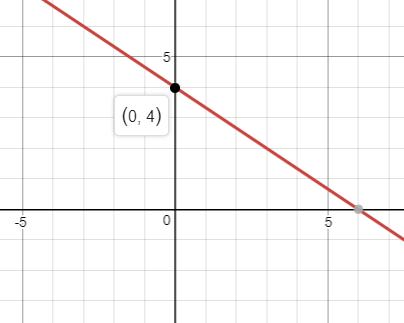
Concept explainers
In Problems 13-20, a linear function is given.
a. Determine the slope and of each Junction.
b. Use the slope and to graph the linear function.
c. Determine the average rate of change of each function.
d. Determine whether the linear function is increasing, decreasing, or constant.
To calculate:
a. Slope and the of the given function.
Answer to Problem 18AYU
Solution:
a. The slope is and is 4.
Explanation of Solution
Given:
The given equation is .
Formula Used:
For a linear function of the form , is the slope and is the .
The average rate of change of the linear function is the slope of that function.
The function is said to be increasing in it domain, then its slope is positive.
The function is said to be decreasing in it domain, then its slope is negative.
The function is said to be constant if the slope is 0.
Calculation:
a. From the definition of the linear function, the slope of the given function is and 4 is the .
To calculate:
b. Use (a. and graph the given function.
Answer to Problem 18AYU
Solution:
b. The graph is as shown below:

Explanation of Solution
Given:
The given equation is .
Formula Used:
For a linear function of the form , is the slope and is the .
The average rate of change of the linear function is the slope of that function.
The function is said to be increasing in it domain, then its slope is positive.
The function is said to be decreasing in it domain, then its slope is negative.
The function is said to be constant if the slope is 0.
Calculation:
b. The graph of the given function is

To calculate:
c. Average rate of change of the given function.
Answer to Problem 18AYU
Solution:
c. Average rate of change of the given function is .
Explanation of Solution
Given:
The given equation is .
Formula Used:
For a linear function of the form , is the slope and is the .
The average rate of change of the linear function is the slope of that function.
The function is said to be increasing in it domain, then its slope is positive.
The function is said to be decreasing in it domain, then its slope is negative.
The function is said to be constant if the slope is 0.
Calculation:
c. The average rate of change of the given function is .
To calculate:
d. Determine whether the function is increasing, decreasing or constant.
Answer to Problem 18AYU
Solution:
d. The function is decreasing.
Explanation of Solution
Given:
The given equation is .
Formula Used:
For a linear function of the form , is the slope and is the .
The average rate of change of the linear function is the slope of that function.
The function is said to be increasing in it domain, then its slope is positive.
The function is said to be decreasing in it domain, then its slope is negative.
The function is said to be constant if the slope is 0.
Calculation:
d. Since the slope of the given function is negative, the function is decreasing.
Chapter 3 Solutions
Precalculus Enhanced with Graphing Utilities
Additional Math Textbook Solutions
Calculus for Business, Economics, Life Sciences, and Social Sciences (14th Edition)
University Calculus: Early Transcendentals (4th Edition)
A First Course in Probability (10th Edition)
A Problem Solving Approach To Mathematics For Elementary School Teachers (13th Edition)
- Please help on both Part b) and c) below Thanksarrow_forwardfind the zeros of the function algebraically: f(x) = 9x2 - 3x - 2arrow_forwardRylee's car is stuck in the mud. Roman and Shanice come along in a truck to help pull her out. They attach one end of a tow strap to the front of the car and the other end to the truck's trailer hitch, and the truck starts to pull. Meanwhile, Roman and Shanice get behind the car and push. The truck generates a horizontal force of 377 lb on the car. Roman and Shanice are pushing at a slight upward angle and generate a force of 119 lb on the car. These forces can be represented by vectors, as shown in the figure below. The angle between these vectors is 20.2°. Find the resultant force (the vector sum), then give its magnitude and its direction angle from the positive x-axis. 119 lb 20.2° 377 lbarrow_forward
- An airplane flies due west at an airspeed of 428 mph. The wind blows in the direction of 41° south of west at 50 mph. What is the ground speed of the airplane? What is the bearing of the airplane?arrow_forwardA vector with magnitude 5 points in a direction 190 degrees counterclockwise from the positive x axis. Write the vector in component form, and show your answers accurate to 3 decimal places.arrow_forward||A||=23 45° Find the EXACT components of the vector above using the angle shown.arrow_forward
- Given ƒ = (10, -10) and q = (-8, −7), find ||ƒ— q|| and dƒ-9. Give EXACT answers. You do NOT have to simplify your radicals!arrow_forwardFind a vector (u) with magnitude 7 in the direction of v = (2,4) Give EXACT answer. You do NOT have to simplify your radicals!arrow_forwardGiven g = (-5, 10) and u = (5, 2), find -4ğ - 6.arrow_forward
- Given the vector v→=⟨3,-5⟩, find the magnitude and angle in which the vector points (measured in radians counterclockwise from the positive x-axis and 0≤θ<2π). Round each decimal number to two places.arrow_forwardplease include radicals in answerarrow_forwardFind the arc length of the curve below on the given interval by integrating with respect to x. 4 4 + 1 8x 2 [1,3]arrow_forward
 Calculus: Early TranscendentalsCalculusISBN:9781285741550Author:James StewartPublisher:Cengage Learning
Calculus: Early TranscendentalsCalculusISBN:9781285741550Author:James StewartPublisher:Cengage Learning Thomas' Calculus (14th Edition)CalculusISBN:9780134438986Author:Joel R. Hass, Christopher E. Heil, Maurice D. WeirPublisher:PEARSON
Thomas' Calculus (14th Edition)CalculusISBN:9780134438986Author:Joel R. Hass, Christopher E. Heil, Maurice D. WeirPublisher:PEARSON Calculus: Early Transcendentals (3rd Edition)CalculusISBN:9780134763644Author:William L. Briggs, Lyle Cochran, Bernard Gillett, Eric SchulzPublisher:PEARSON
Calculus: Early Transcendentals (3rd Edition)CalculusISBN:9780134763644Author:William L. Briggs, Lyle Cochran, Bernard Gillett, Eric SchulzPublisher:PEARSON Calculus: Early TranscendentalsCalculusISBN:9781319050740Author:Jon Rogawski, Colin Adams, Robert FranzosaPublisher:W. H. Freeman
Calculus: Early TranscendentalsCalculusISBN:9781319050740Author:Jon Rogawski, Colin Adams, Robert FranzosaPublisher:W. H. Freeman
 Calculus: Early Transcendental FunctionsCalculusISBN:9781337552516Author:Ron Larson, Bruce H. EdwardsPublisher:Cengage Learning
Calculus: Early Transcendental FunctionsCalculusISBN:9781337552516Author:Ron Larson, Bruce H. EdwardsPublisher:Cengage Learning





